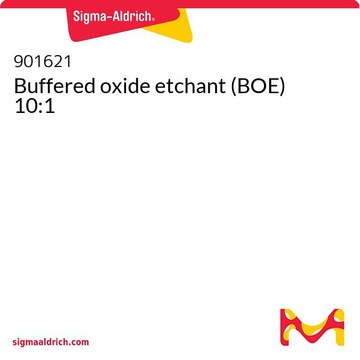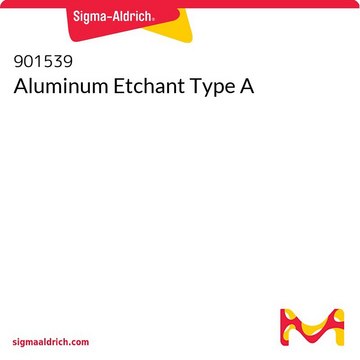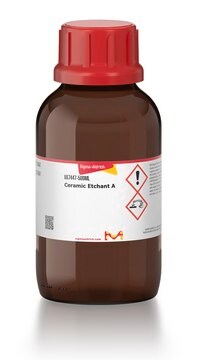Recommended Products
Related Categories
General description
Tungsten etchant is a mixture of potassium hydroxide and potassium ferricyanide based solution that facilitates the removal of tungsten and other materials like aluminium by dipping the substrate into the etching solution.
Application
Selective etchants for tungsten thin-film metallizations used in semiconductor and microelectronics technology. Etchants are buffered, mildly alkaline ferricyanide-based formulations providing high resolution patterns with minimal undercutting and photoresist compatibility. Etchant is ready to use (no dilution required). Controlled, uniform etching is achieved by immersion or spray etch technique. Etch Capacity (rate declines at ∼70%) of 64 g/gallon. Recommended Operating Temperatures: 20-80 °C (30-40 °C most common).
Preparation Note
- 20°C = 30 Å/second
- 30°C = 140 Å/second 20°C = 80 Å/second
- 60°C = 250 Å/second
Signal Word
Danger
Hazard Statements
Precautionary Statements
Hazard Classifications
Aquatic Chronic 3 - Eye Dam. 1 - Met. Corr. 1 - Skin Corr. 1A
Supplementary Hazards
Storage Class Code
8B - Non-combustible corrosive hazardous materials
WGK
WGK 2
Flash Point(F)
Not applicable
Flash Point(C)
Not applicable
Personal Protective Equipment
dust mask type N95 (US), Eyeshields, Gloves
Choose from one of the most recent versions:
Already Own This Product?
Find documentation for the products that you have recently purchased in the Document Library.
Pattern processing results and characteristics for SCALPEL masks.
Novembre AE, et al.
Microelectronic Engineering, 46(1-4), 271-274 (1999)
Microstructure Evolution of W-Cu Alloy Wire.
Shao F, et al.
Materials Sciences and Applications, 3(03), 157-157 (2012)
Electrostatically actuated copper-blade microrelays.
Lee H, et al.
Sensors and actuators A, Physical, 100(1), 105-113 (2002)
Our team of scientists has experience in all areas of research including Life Science, Material Science, Chemical Synthesis, Chromatography, Analytical and many others.
Contact Technical Service









